Abstract
The human complement components C4A and C4B are highly homologous proteins, but they show markedly different, class-specific, chemical reactivities. They also differ serologically in that C4A generally expresses the Rodgers (Rg) blood group antigens while C4B generally expresses the Chido (Ch) blood group antigens. C4A 1 and C4B 5 are exceptional variants which possess their class-specific chemical reactivities, but express essentially the reversed antigenicities. The genes encoding the typical Rg-positive C4A 3a and Ch-positive C4B 3 allotypes and the interesting variants C4A 1 and C4B 5 have been cloned. Characterization of the cloned DNA has revealed that the genes encoding the A 3a, A 1 and B 3 allotypes are 22 kb long, but that encoding B 5 is only 16 kb long. Comparison of derived amino acid sequences of the polymorphic C4d fragment has shown that C4A and C4B can be defined by only four isotypic amino acid differences at position 1101-1106. Over this region C4A has the sequence PCPVLD while C4B has the sequence LSPVIH, and this presumably is the cause of their different chemical reactivities. Moreover, the probable locations of the two Rg and the six Ch antigenic determinants have been deduced. Our structural data on the C4A and C4B polymorphism pattern suggests a gene conversion-like mechanism is operating in mixing the generally discrete serological phenotypes between C4A and C4B.
Full text
PDF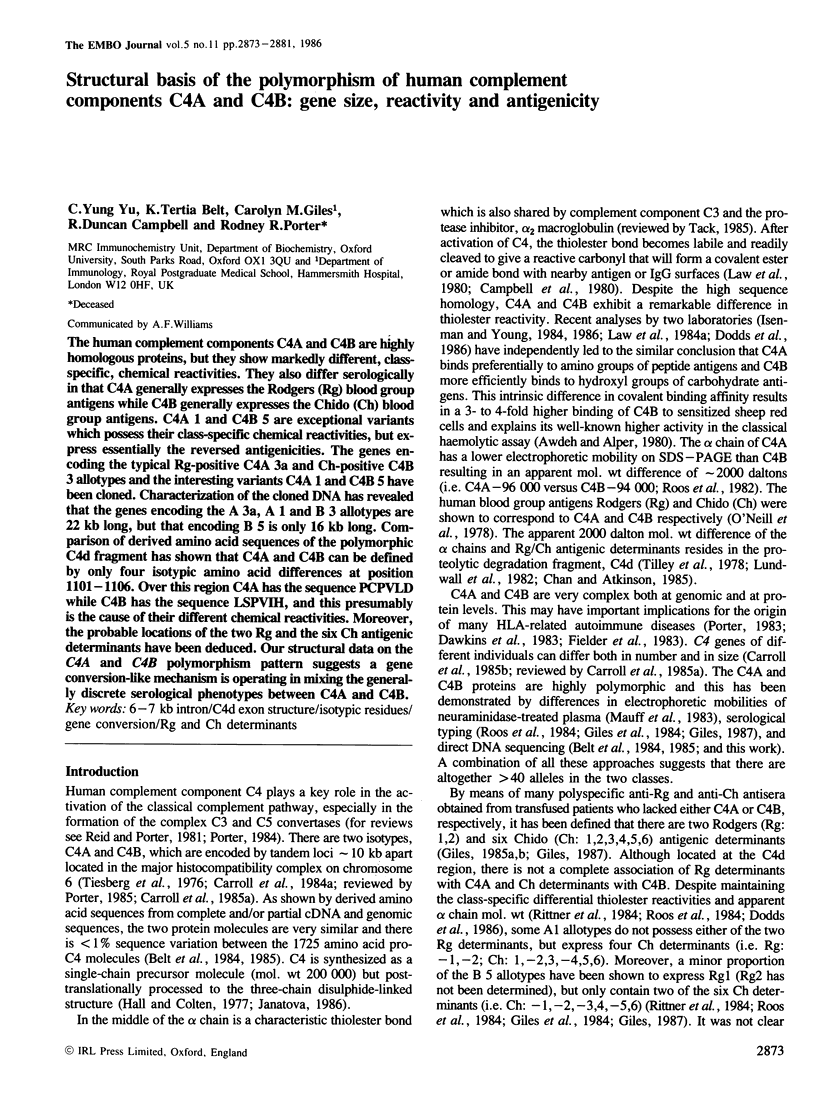
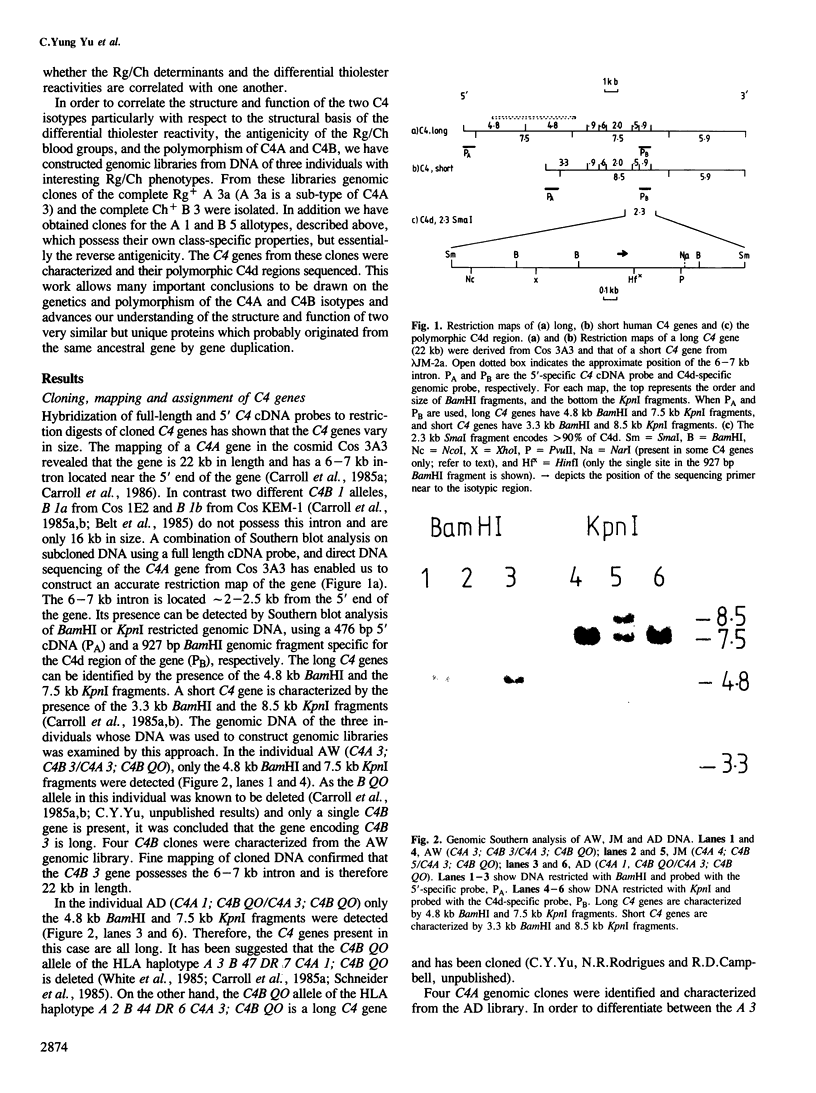
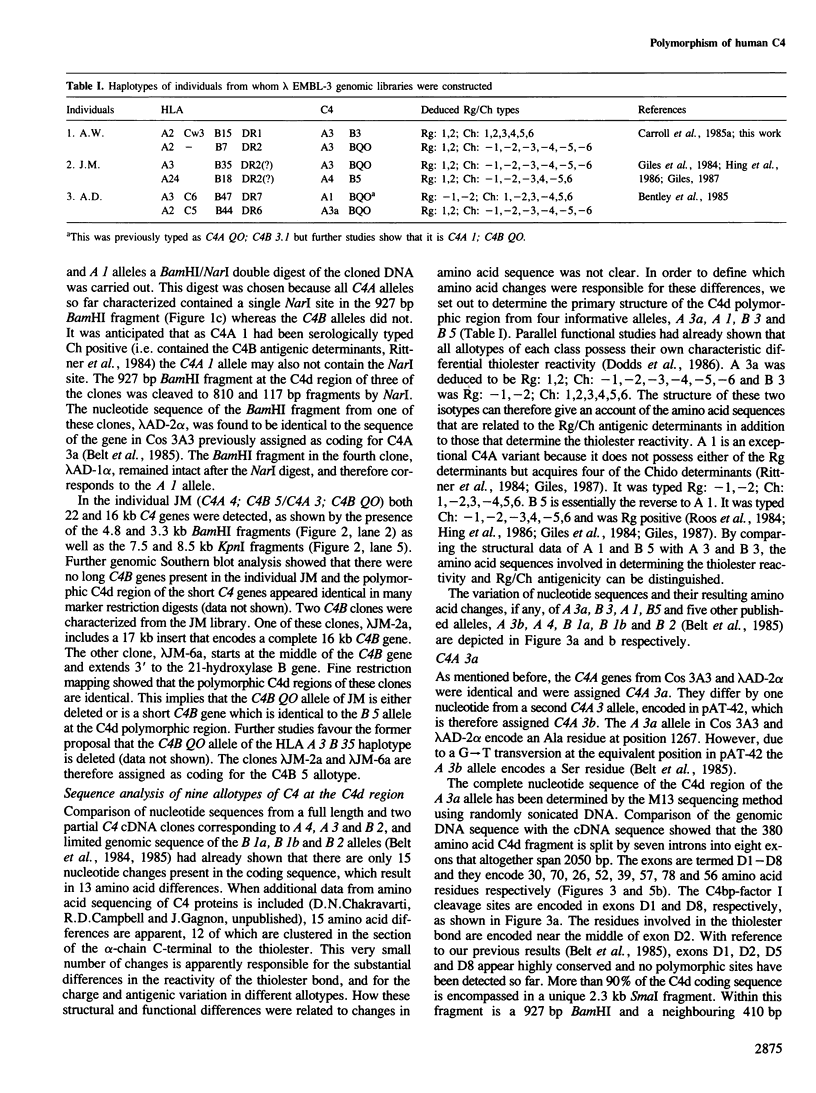
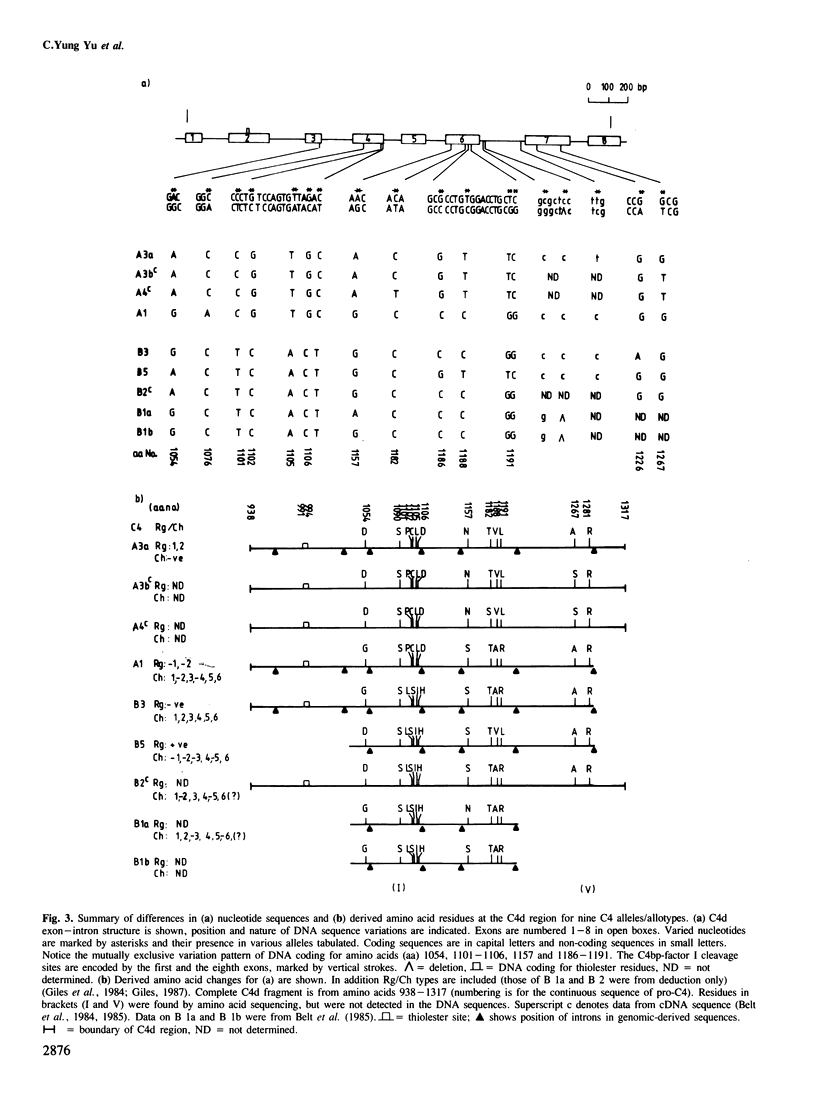
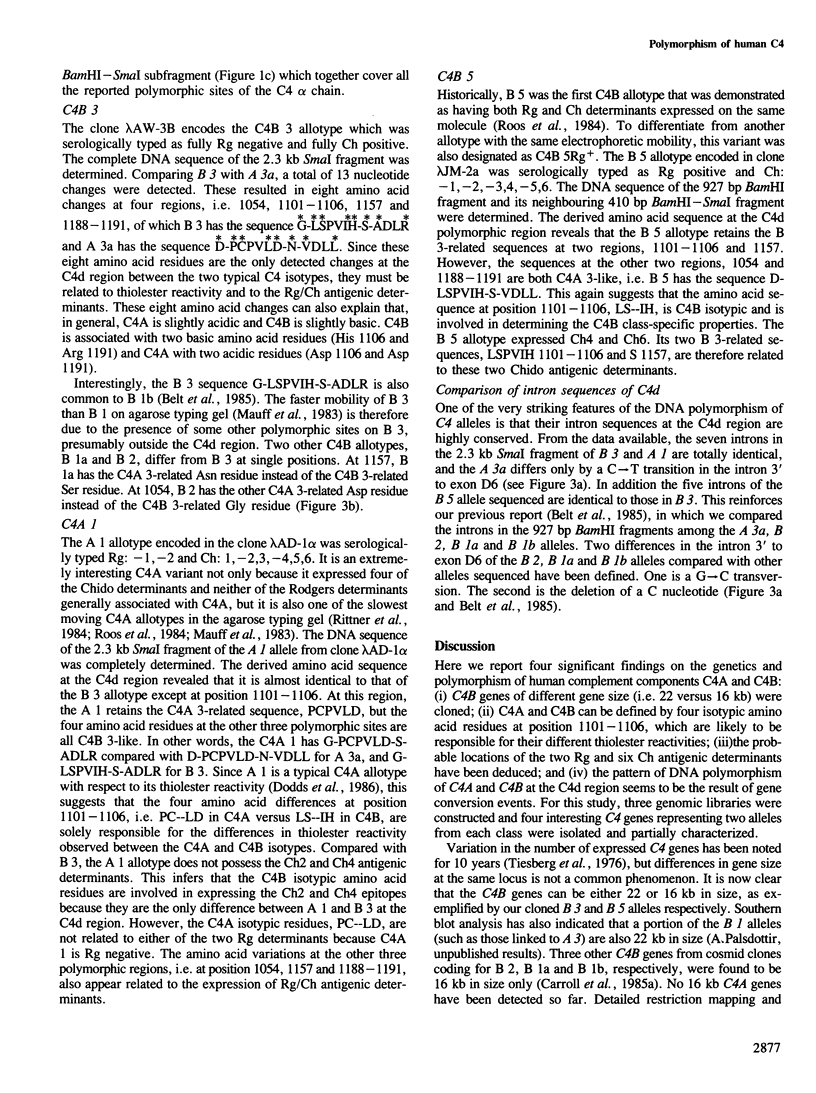
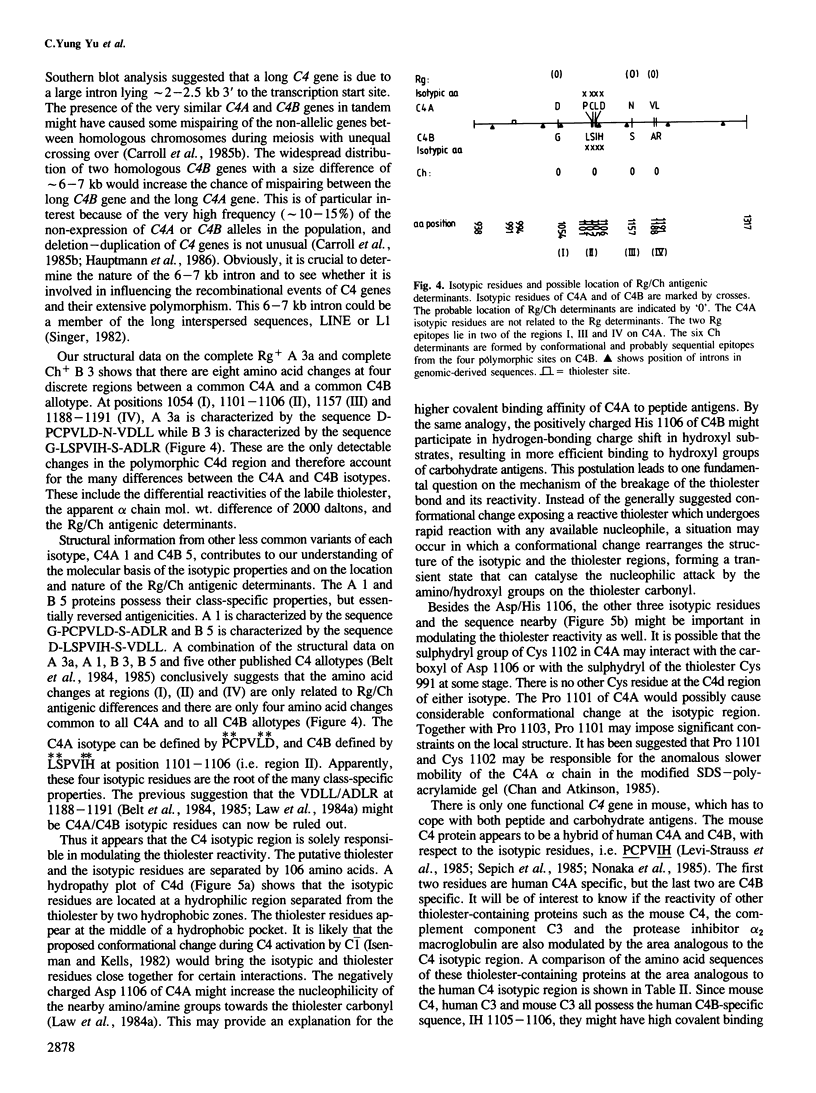
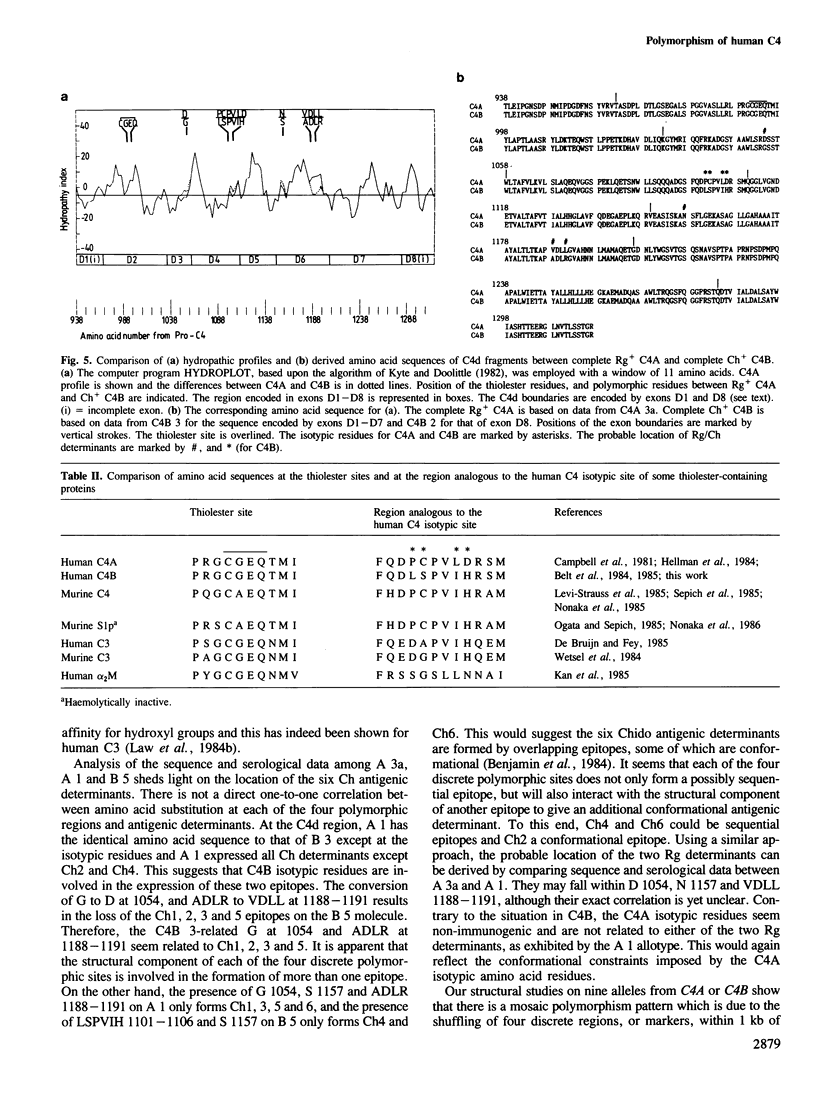
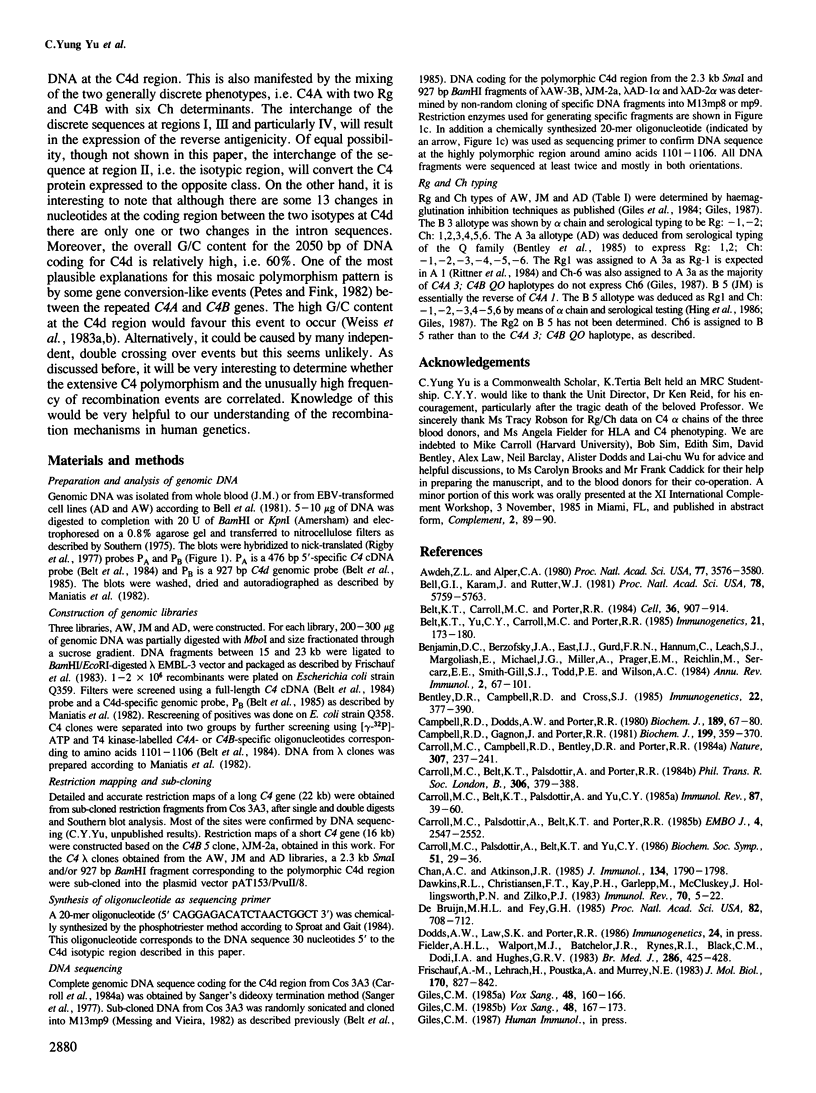
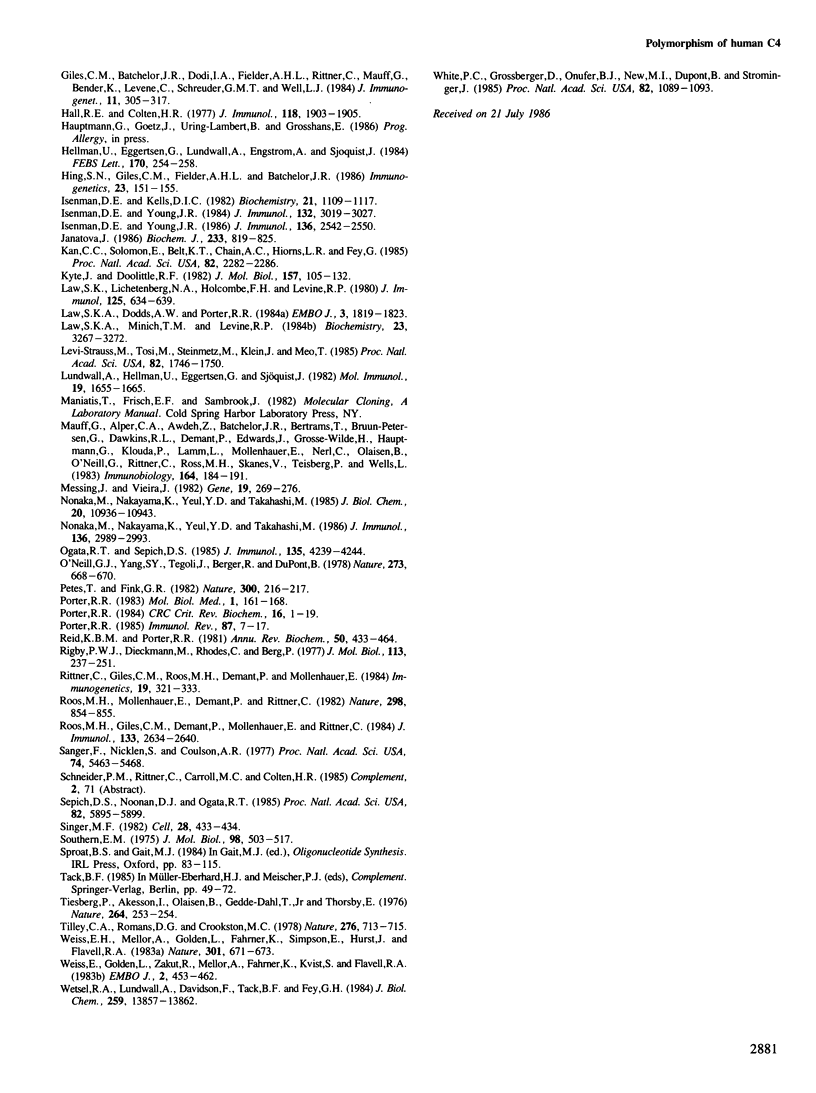
Images in this article
Selected References
These references are in PubMed. This may not be the complete list of references from this article.
- Awdeh Z. L., Alper C. A. Inherited structural polymorphism of the fourth component of human complement. Proc Natl Acad Sci U S A. 1980 Jun;77(6):3576–3580. doi: 10.1073/pnas.77.6.3576. [DOI] [PMC free article] [PubMed] [Google Scholar]
- Bell G. I., Karam J. H., Rutter W. J. Polymorphic DNA region adjacent to the 5' end of the human insulin gene. Proc Natl Acad Sci U S A. 1981 Sep;78(9):5759–5763. doi: 10.1073/pnas.78.9.5759. [DOI] [PMC free article] [PubMed] [Google Scholar]
- Belt K. T., Carroll M. C., Porter R. R. The structural basis of the multiple forms of human complement component C4. Cell. 1984 Apr;36(4):907–914. doi: 10.1016/0092-8674(84)90040-0. [DOI] [PubMed] [Google Scholar]
- Belt K. T., Yu C. Y., Carroll M. C., Porter R. R. Polymorphism of human complement component C4. Immunogenetics. 1985;21(2):173–180. doi: 10.1007/BF00364869. [DOI] [PubMed] [Google Scholar]
- Benjamin D. C., Berzofsky J. A., East I. J., Gurd F. R., Hannum C., Leach S. J., Margoliash E., Michael J. G., Miller A., Prager E. M. The antigenic structure of proteins: a reappraisal. Annu Rev Immunol. 1984;2:67–101. doi: 10.1146/annurev.iy.02.040184.000435. [DOI] [PubMed] [Google Scholar]
- Bentley D. R., Campbell R. D., Cross S. J. DNA polymorphism of the C2 locus. Immunogenetics. 1985;22(4):377–390. doi: 10.1007/BF00430921. [DOI] [PubMed] [Google Scholar]
- Campbell R. D., Dodds A. W., Porter R. R. The binding of human complement component C4 to antibody-antigen aggregates. Biochem J. 1980 Jul 1;189(1):67–80. doi: 10.1042/bj1890067. [DOI] [PMC free article] [PubMed] [Google Scholar]
- Campbell R. D., Gagnon J., Porter R. R. Amino acid sequence around the thiol and reactive acyl groups of human complement component C4. Biochem J. 1981 Nov 1;199(2):359–370. doi: 10.1042/bj1990359. [DOI] [PMC free article] [PubMed] [Google Scholar]
- Carroll M. C., Belt K. T., Palsdottir A., Yu Y. Molecular genetics of the fourth component of human complement and steroid 21-hydroxylase. Immunol Rev. 1985 Oct;87:39–60. doi: 10.1111/j.1600-065x.1985.tb01144.x. [DOI] [PubMed] [Google Scholar]
- Carroll M. C., Belt T., Palsdottir A., Porter R. R. Structure and organization of the C4 genes. Philos Trans R Soc Lond B Biol Sci. 1984 Sep 6;306(1129):379–388. doi: 10.1098/rstb.1984.0098. [DOI] [PubMed] [Google Scholar]
- Carroll M. C., Campbell R. D., Bentley D. R., Porter R. R. A molecular map of the human major histocompatibility complex class III region linking complement genes C4, C2 and factor B. Nature. 1984 Jan 19;307(5948):237–241. doi: 10.1038/307237a0. [DOI] [PubMed] [Google Scholar]
- Carroll M. C., Palsdottir A., Belt K. T., Porter R. R. Deletion of complement C4 and steroid 21-hydroxylase genes in the HLA class III region. EMBO J. 1985 Oct;4(10):2547–2552. doi: 10.1002/j.1460-2075.1985.tb03969.x. [DOI] [PMC free article] [PubMed] [Google Scholar]
- Carroll M. C., Palsdottir A., Belt K. T., Yu C. Y. Molecular genetics of the fourth component of human complement. Biochem Soc Symp. 1986;51:29–36. [PubMed] [Google Scholar]
- Chan A. C., Atkinson J. P. Oligosaccharide structure of human C4. J Immunol. 1985 Mar;134(3):1790–1798. [PubMed] [Google Scholar]
- Fielder A. H., Walport M. J., Batchelor J. R., Rynes R. I., Black C. M., Dodi I. A., Hughes G. R. Family study of the major histocompatibility complex in patients with systemic lupus erythematosus: importance of null alleles of C4A and C4B in determining disease susceptibility. Br Med J (Clin Res Ed) 1983 Feb 5;286(6363):425–428. doi: 10.1136/bmj.286.6363.425. [DOI] [PMC free article] [PubMed] [Google Scholar]
- Frischauf A. M., Lehrach H., Poustka A., Murray N. Lambda replacement vectors carrying polylinker sequences. J Mol Biol. 1983 Nov 15;170(4):827–842. doi: 10.1016/s0022-2836(83)80190-9. [DOI] [PubMed] [Google Scholar]
- Giles C. M. 'Partial inhibition' of anti-Rg and anti-Ch reagents. I. Assessment for Rg/Ch typing by inhibition. Vox Sang. 1985;48(3):160–166. doi: 10.1111/j.1423-0410.1985.tb00164.x. [DOI] [PubMed] [Google Scholar]
- Giles C. M. 'Partial inhibition' of anti-Rg and anti-Ch reagents. II. Demonstration of separable antibodies for different determinants. Vox Sang. 1985;48(3):167–173. doi: 10.1111/j.1423-0410.1985.tb00165.x. [DOI] [PubMed] [Google Scholar]
- Giles C. M., Batchelor J. R., Dodi I. A., Fielder A. H., Rittner C., Mauff G., Bender K., Levene C., Schreuder G. M., Wells L. J. C4 and HLA haplotypes associated with partial inhibition of anti-Rg and anti-Ch. J Immunogenet. 1984 Oct-Dec;11(5-6):305–317. doi: 10.1111/j.1744-313x.1984.tb00817.x. [DOI] [PubMed] [Google Scholar]
- Hall R. E., Colten H. R. Molecular size and subunit structure of the fourth component of guinea pig complement. J Immunol. 1977 May;118(5):1903–1905. [PubMed] [Google Scholar]
- Hellman U., Eggertsen G., Lundwall A., Engström A., Sjöquist J. Primary sequence differences between Chido and Rodgers variants of tryptic C4d of the human complement system. FEBS Lett. 1984 May 21;170(2):254–258. doi: 10.1016/0014-5793(84)81323-x. [DOI] [PubMed] [Google Scholar]
- Hing S. N., Giles C. M., Fielder A. H., Batchelor J. R. HLA haplotypes with C4B5; evidence for further allelic heterogeneity. Immunogenetics. 1986;23(3):151–155. doi: 10.1007/BF00373815. [DOI] [PubMed] [Google Scholar]
- Isenman D. E., Kells D. I. Conformational and functional changes in the fourth component of human complement produced by nucleophilic modification and by proteolysis with C1s-. Biochemistry. 1982 Mar 16;21(6):1109–1117. doi: 10.1021/bi00535a001. [DOI] [PubMed] [Google Scholar]
- Isenman D. E., Young J. R. Covalent binding properties of the C4A and C4B isotypes of the fourth component of human complement on several C1-bearing cell surfaces. J Immunol. 1986 Apr 1;136(7):2542–2550. [PubMed] [Google Scholar]
- Isenman D. E., Young J. R. The molecular basis for the difference in immune hemolysis activity of the Chido and Rodgers isotypes of human complement component C4. J Immunol. 1984 Jun;132(6):3019–3027. [PubMed] [Google Scholar]
- Janatova J. Detection of disulphide bonds and localization of interchain linkages in the third (C3) and the fourth (C4) components of human complement. Biochem J. 1986 Feb 1;233(3):819–825. doi: 10.1042/bj2330819. [DOI] [PMC free article] [PubMed] [Google Scholar]
- Kan C. C., Solomon E., Belt K. T., Chain A. C., Hiorns L. R., Fey G. Nucleotide sequence of cDNA encoding human alpha 2-macroglobulin and assignment of the chromosomal locus. Proc Natl Acad Sci U S A. 1985 Apr;82(8):2282–2286. doi: 10.1073/pnas.82.8.2282. [DOI] [PMC free article] [PubMed] [Google Scholar]
- Kyte J., Doolittle R. F. A simple method for displaying the hydropathic character of a protein. J Mol Biol. 1982 May 5;157(1):105–132. doi: 10.1016/0022-2836(82)90515-0. [DOI] [PubMed] [Google Scholar]
- Law S. K., Dodds A. W., Porter R. R. A comparison of the properties of two classes, C4A and C4B, of the human complement component C4. EMBO J. 1984 Aug;3(8):1819–1823. doi: 10.1002/j.1460-2075.1984.tb02052.x. [DOI] [PMC free article] [PubMed] [Google Scholar]
- Law S. K., Lichtenberg N. A., Holcombe F. H., Levine R. P. Interaction between the labile binding sites of the fourth (C4) and fifth (C5) human complement proteins and erythrocyte cell membranes. J Immunol. 1980 Aug;125(2):634–639. [PubMed] [Google Scholar]
- Law S. K., Minich T. M., Levine R. P. Covalent binding efficiency of the third and fourth complement proteins in relation to pH, nucleophilicity, and availability of hydroxyl groups. Biochemistry. 1984 Jul 3;23(14):3267–3272. doi: 10.1021/bi00309a022. [DOI] [PubMed] [Google Scholar]
- Levi-Strauss M., Tosi M., Steinmetz M., Klein J., Meo T. Multiple duplications of complement C4 gene correlate with H-2-controlled testosterone-independent expression of its sex-limited isoform, C4-Slp. Proc Natl Acad Sci U S A. 1985 Mar;82(6):1746–1750. doi: 10.1073/pnas.82.6.1746. [DOI] [PMC free article] [PubMed] [Google Scholar]
- Lundwall A., Hellman U., Eggertsen G., Sjöquist J. Isolation of tryptic fragments of human C4 expressing Chido and Rodgers antigens. Mol Immunol. 1982 Dec;19(12):1655–1665. doi: 10.1016/0161-5890(82)90277-2. [DOI] [PubMed] [Google Scholar]
- Mauff G., Alper C. A., Awdeh Z., Batchelor J. R., Bertrams J., Bruun-Petersen G., Dawkins R. L., Démant P., Edwards J., Grosse-Wilde H. Statement on the nomenclature of human C4 allotypes. Immunobiology. 1983 Mar;164(2):184–191. doi: 10.1016/s0171-2985(83)80009-6. [DOI] [PubMed] [Google Scholar]
- Messing J., Vieira J. A new pair of M13 vectors for selecting either DNA strand of double-digest restriction fragments. Gene. 1982 Oct;19(3):269–276. doi: 10.1016/0378-1119(82)90016-6. [DOI] [PubMed] [Google Scholar]
- Nonaka M., Nakayama K., Yeul Y. D., Takahashi M. Complete nucleotide and derived amino acid sequences of sex-limited protein (Slp), nonfunctional isotype of the fourth component of mouse complement (C4). J Immunol. 1986 Apr 15;136(8):2989–2993. [PubMed] [Google Scholar]
- Nonaka M., Nakayama K., Yeul Y. D., Takahashi M. Complete nucleotide and derived amino acid sequences of the fourth component of mouse complement (C4). Evolutionary aspects. J Biol Chem. 1985 Sep 15;260(20):10936–10943. [PubMed] [Google Scholar]
- O'Neill G. J., Yang S. Y., Tegoli J., Berger R., Dupont B. Chido and Rodgers blood groups are distinct antigenic components of human complement C4. Nature. 1978 Jun 22;273(5664):668–670. doi: 10.1038/273668a0. [DOI] [PubMed] [Google Scholar]
- Ogata R. T., Sepich D. S. Murine sex-limited protein: complete cDNA sequence and comparison with murine fourth complement component. J Immunol. 1985 Dec;135(6):4239–4244. [PubMed] [Google Scholar]
- Petes T., Fink G. R. Gene conversion between repeated genes. Nature. 1982 Nov 18;300(5889):216–217. doi: 10.1038/300216a0. [DOI] [PubMed] [Google Scholar]
- Porter R. R. Complement polymorphism, the major histocompatibility complex and associated diseases: a speculation. Mol Biol Med. 1983 Jul;1(1):161–168. [PubMed] [Google Scholar]
- Porter R. R. The complement components coded in the major histocompatibility complexes and their biological activities. Immunol Rev. 1985 Oct;87:7–17. doi: 10.1111/j.1600-065x.1985.tb01142.x. [DOI] [PubMed] [Google Scholar]
- Porter R. R. The complement components of the major histocompatibility locus. CRC Crit Rev Biochem. 1984;16(1):1–19. doi: 10.3109/10409238409102804. [DOI] [PubMed] [Google Scholar]
- Reid K. B., Porter R. R. The proteolytic activation systems of complement. Annu Rev Biochem. 1981;50:433–464. doi: 10.1146/annurev.bi.50.070181.002245. [DOI] [PubMed] [Google Scholar]
- Rigby P. W., Dieckmann M., Rhodes C., Berg P. Labeling deoxyribonucleic acid to high specific activity in vitro by nick translation with DNA polymerase I. J Mol Biol. 1977 Jun 15;113(1):237–251. doi: 10.1016/0022-2836(77)90052-3. [DOI] [PubMed] [Google Scholar]
- Rittner C., Giles C. M., Roos M. H., Démant P., Mollenhauer E. Genetics of human C4 polymorphism: detection and segregation of rare and duplicated haplotypes. Immunogenetics. 1984;19(4):321–333. doi: 10.1007/BF00345405. [DOI] [PubMed] [Google Scholar]
- Roos M. H., Giles C. M., Demant P., Mollenhauer E., Rittner C. Rodgers (Rg) and Chido (Ch) determinants on human C4: characterization of two C4 B5 subtypes, one of which contains Rg and Ch determinants. J Immunol. 1984 Nov;133(5):2634–2640. [PubMed] [Google Scholar]
- Roos M. H., Mollenhauer E., Démant P., Rittner C. A molecular basis for the two locus model of human complement component C4. Nature. 1982 Aug 26;298(5877):854–856. doi: 10.1038/298854a0. [DOI] [PubMed] [Google Scholar]
- Sanger F., Nicklen S., Coulson A. R. DNA sequencing with chain-terminating inhibitors. Proc Natl Acad Sci U S A. 1977 Dec;74(12):5463–5467. doi: 10.1073/pnas.74.12.5463. [DOI] [PMC free article] [PubMed] [Google Scholar]
- Sepich D. S., Noonan D. J., Ogata R. T. Complete cDNA sequence of the fourth component of murine complement. Proc Natl Acad Sci U S A. 1985 Sep;82(17):5895–5899. doi: 10.1073/pnas.82.17.5895. [DOI] [PMC free article] [PubMed] [Google Scholar]
- Singer M. F. SINEs and LINEs: highly repeated short and long interspersed sequences in mammalian genomes. Cell. 1982 Mar;28(3):433–434. doi: 10.1016/0092-8674(82)90194-5. [DOI] [PubMed] [Google Scholar]
- Southern E. M. Detection of specific sequences among DNA fragments separated by gel electrophoresis. J Mol Biol. 1975 Nov 5;98(3):503–517. doi: 10.1016/s0022-2836(75)80083-0. [DOI] [PubMed] [Google Scholar]
- Teisberg P., Akesson I., Olaisen B., Gedde-Dahl T., Jr, Thorsby E. Genetic polymorphism of C4 in man and localisation of a structural C4 locus to the HLA gene complex of chromosome 6. Nature. 1976 Nov 18;264(5583):253–254. doi: 10.1038/264253a0. [DOI] [PubMed] [Google Scholar]
- Tilley C. A., Romans D. G., Crookston M. C. Localisation of Chido and Rodgers determinants to the C4d fragment of human C4. Nature. 1978 Dec 14;276(5689):713–715. doi: 10.1038/276713a0. [DOI] [PubMed] [Google Scholar]
- Weiss E. H., Mellor A., Golden L., Fahrner K., Simpson E., Hurst J., Flavell R. A. The structure of a mutant H-2 gene suggests that the generation of polymorphism in H-2 genes may occur by gene conversion-like events. Nature. 1983 Feb 24;301(5902):671–674. doi: 10.1038/301671a0. [DOI] [PubMed] [Google Scholar]
- Weiss E., Golden L., Zakut R., Mellor A., Fahrner K., Kvist S., Flavell R. A. The DNA sequence of the H-2kb gene: evidence for gene conversion as a mechanism for the generation of polymorphism in histocompatibilty antigens. EMBO J. 1983;2(3):453–462. doi: 10.1002/j.1460-2075.1983.tb01444.x. [DOI] [PMC free article] [PubMed] [Google Scholar]
- Wetsel R. A., Lundwall A., Davidson F., Gibson T., Tack B. F., Fey G. H. Structure of murine complement component C3. II. Nucleotide sequence of cloned complementary DNA coding for the alpha chain. J Biol Chem. 1984 Nov 25;259(22):13857–13862. [PubMed] [Google Scholar]
- White P. C., Grossberger D., Onufer B. J., Chaplin D. D., New M. I., Dupont B., Strominger J. L. Two genes encoding steroid 21-hydroxylase are located near the genes encoding the fourth component of complement in man. Proc Natl Acad Sci U S A. 1985 Feb;82(4):1089–1093. doi: 10.1073/pnas.82.4.1089. [DOI] [PMC free article] [PubMed] [Google Scholar]
- de Bruijn M. H., Fey G. H. Human complement component C3: cDNA coding sequence and derived primary structure. Proc Natl Acad Sci U S A. 1985 Feb;82(3):708–712. doi: 10.1073/pnas.82.3.708. [DOI] [PMC free article] [PubMed] [Google Scholar]



